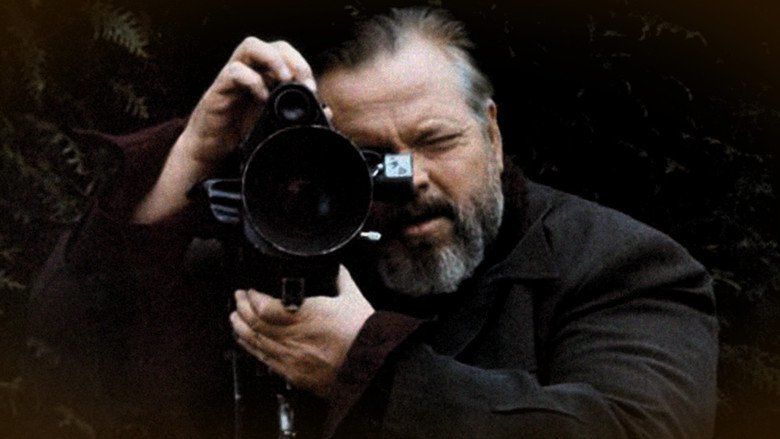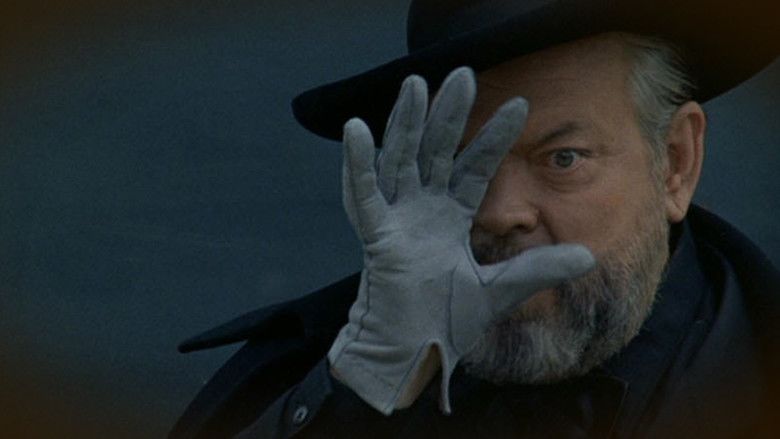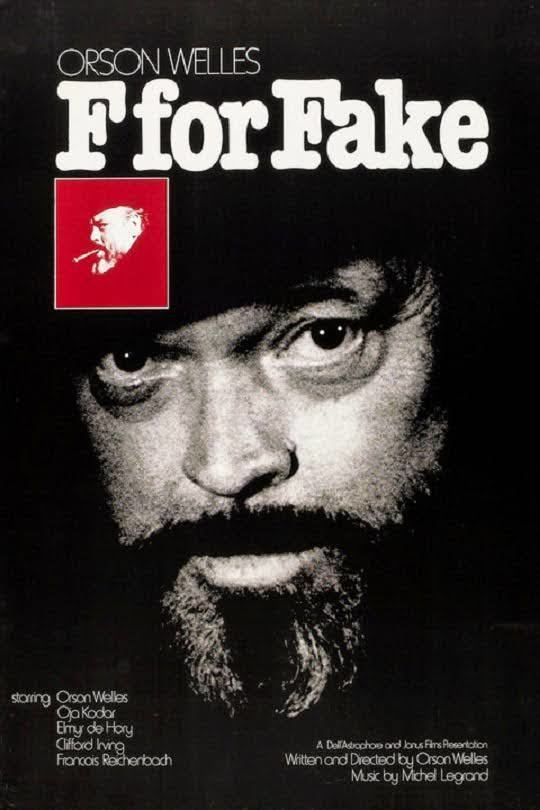F for Fake
8 /10 1 Votes
3/4 Roger Ebert Initial DVD release April 26, 2005 Duration | 7.8/10 IMDb 89% Rotten Tomatoes Genre Documentary Writer Orson Welles | |||||||||||||||||||||||||||||||||
 | ||||||||||||||||||||||||||||||||||
Language English / French / Spanish Release date September 25, 1975 Cast Orson Welles (Himself), (Special Participant), (The Girl), (Himself (uncredited)), (Himself (uncredited)), (Himself)Similar movies Drama in the Desert: The Sights and Sounds of Burning Man , AquaBurn , Dust Devils , Blackhat , Andy Warhol , Salt | ||||||||||||||||||||||||||||||||||
f for fake original trailer by orson welles 1976
F for Fake (French: Vérités et mensonges, "Truths and lies") is the last major film completed by Orson Welles, who directed, co-wrote, and starred in the film. Initially released in 1974, it focuses on Elmyr de Hory's recounting of his career as a professional art forger; de Hory's story serves as the backdrop for a fast-paced, meandering investigation of the natures of authorship and authenticity, as well as the basis of the value of art. Loosely a documentary, the film operates in several different genres and has been described as a kind of film essay.
Contents
- f for fake original trailer by orson welles 1976
- Background
- Plot
- Cast
- Others
- Locations
- Trailer
- Reception
- Style
- Questions of truthfulness
- Home video releases
- References

Far from serving as a traditional documentary on Elmyr de Hory, the film also incorporates Welles's companion Oja Kodar, notorious "hoax-biographer" Clifford Irving, and Orson Welles as himself.

In addition to the 88-minute film, in 1976 Welles also shot and edited a self-contained 9-minute short film as a "trailer", almost entirely composed of original material not found in the main film itself.

Background

Orson Welles was hired to edit a documentary by François Reichenbach about the art forger Elmyr de Hory. The film grew over time to encompass de Hory, as well as de Hory's biographer Clifford Irving, who was revealed to be a forger himself. Welles used these circumstances to produce a meditation on the nature of fakery.
Several storylines are presented in the film, including those of de Hory, Irving, Welles, Howard Hughes and Kodar. About de Hory, we learn that he was a struggling artist who turned to forgery out of desperation, only to see the greater share of the profits from his deceptions go to doubly unscrupulous art dealers. As partial compensation for that injustice, he is maintained in a villa in Ibiza by one of his dealers. What is only hinted at in Welles's documentary is that de Hory had recently served a two-month sentence in a Spanish prison for homosexuality and consorting with criminals. (De Hory would commit suicide two years after the initial release of Welles' film, on hearing that Spain had agreed to turn him over to the French authorities.)
Irving's original part in F for Fake was as de Hory's biographer, but his part grew unexpectedly at some point during production. There has not always been agreement among commentators over just how that production unfolded, but the now-accepted story is that the director François Reichenbach shot a documentary about de Hory and Irving before giving his footage to Welles, who then shot additional footage with Reichenbach as his cinematographer.
In the time between the shooting of Reichenbach's documentary and the finishing of Welles', it became known that Irving had perpetrated a hoax of his own, namely a fabricated "authorized biography" of Howard Hughes (the hoax was later fictionalized in The Hoax). This discovery prompted the shooting of still more footage, which then got woven into F for Fake. Interweaving the narratives even more, there are several pieces of footage in the film showing Welles at a party with De Hory, and, at one point, De Hory even signs a painting with a forgery of Welles' signature. Some of Hughes' career is outlined in the form of a parody of the "News on the March" sequence in Citizen Kane. Welles also draws parallels between the De Hory and Irving hoaxes and his own brush with early notoriety by including a recreation of part of his 1938 War of the Worlds radio drama, which had simulated a newscast about a Martian invasion and sparked panic among some listeners.
The story about Kodar, her grandfather, and Picasso and some forger paintings that the grandfather supposedly made is presented at the end of the film before Welles reminds the viewer that he only promised to tell the truth for an hour and that "for the last 17 minutes, I've been lying my head off." In the commentary to the Criterion Collection DVD release of F for Fake, Kodar claims the idea for this segment as her own. She also claims credit for the movie's opening sequence, which consists of shots of a miniskirt-clad Kodar walking down streets while rubbernecking male admirers (unaware that they are being filmed) stop and openly stare. This sequence is described by Kodar as inspired by her feminism; in his narration, Welles claims the footage was originally shot for an unrelated production.
Plot
The film opens with Welles performing magic tricks for some children while Kodar watches nearby. Welles quotes Robert-Houdin to the effect that a magician is just an actor. Welles promises that for the next hour everything in the film will be based on solid fact. Kodar is then shown strolling around a street in a miniskirt while being ogled by the men on the street. Welles reveals the footage is taken from another experiment about girl-watching, where Kodar deliberately drew attention to herself and the men were unaware they were being filmed. Welles says her story will continue later in the film, and then narrates the story of Elmyr de Hory, an art forger who sold many fake paintings to museums and collectors all over the world. Elmyr is shown throwing a dinner party at his home in Ibiza and being feted by European society, although he dances around the question of whether he is guilty or not. One of those filmed is Clifford Irving, who had published a biography of Elmyr called Fake, and later in a notorious scandal was revealed to have been the forger of Howard Hughes's diary. Welles discusses the irony of Irving commenting on Elmyr's forgery while having committed a version of it himself. Irving and Elmyr tell about the art dealers who were fooled by the forgeries, and Welles considers the question whether this means art dealers and appraisers are fake also.
Welles presents more of Irving's story of having had secret contact with Hughes, and the odd stories of Hughes's behavior that may or may not have been true. He wonders if believing such stories makes a person credulous or not, and questions the true wisdom of so-called experts, who verified Irving's forgery as authentic. Reichenbach is shown telling how Elmyr provided him with several paintings of questionable authenticity, but the art dealers he gave them to were willfully blind to it. Welles notes that Elmyr doesn't even own the house he lives in; it's provided for him by an art dealer. Welles recounts his own past use of fakery: how he got a job in Ireland by falsely claiming to be a famous New York actor, and how his broadcast of War of the Worlds made deliberate use of fake news to enhance the story. He also notes the coincidence that his first film Citizen Kane was originally going to be a fictionalized version of Howard Hughes.
Irving describes how Elmyr was nearly destitute when younger and subsisted in America by making and selling forgeries that were indistinguishable from the real works, while remaining one step ahead of the law through frequent relocations. He finally moved to Ibiza, but was not prosecuted for lack of witnesses to the actual forging, as well as the scandal that might be aroused by revealing the depth of the art market's complicity in the deception. Elmyr insists he never signed any forgery, and Welles wonders whether, given the fact that all art eventually falls away to ruin, a signature truly matters to any art work. He illustrates the point by shots of the cathedral of Chartres, pointing out that the names of the men who created the magnificent building and the sculptures which adorn it are unknown. They did not sign their work, but it has endured.
Welles finally presents Kodar's story: she holidayed in the same village as Picasso, who noticed her and painted 22 pieces with her as the model. She insisted she be allowed to keep the paintings, but later when Picasso read about an acclaimed exhibit of 22 new pieces of his, he flew there in a rage, only to discover the pieces were all forgeries. Kodar took Picasso to her grandfather, the forger, who defended his work with pride while Picasso angrily demanded the paintings back. This dialogue is presented by Welles and Kodar re-enacting the parts of the grandfather and Picasso respectively. Welles then confesses that he had promised everything in the "next hour" was true, and that hour had already passed. He admits the entire story of Kodar, her grandfather, and Picasso was made up. He apologizes, quotes Picasso's statement that art is a lie that makes us see the truth, and bids the audience good night.
Cast
Others
Locations
Trailer
F for Fake was not released in the USA until 1976. When it finally came out, Welles produced a preview "trailer" for it, which was effectively a wholly original 9-minute film, shot and edited in a similar style to the film itself. Apart from some very brief split-second camera shots, the entire film is a self-contained short containing original material starring Welles, Gary Graver and Oja Kodar. No cinema distributor was willing to show the choppy 9-minute film (that suffered from the fact that it was largely created, starring, shot by, narrated and edited by awkward B-movie cinematographer, Graver). Welles allegedly ran out of money making the film and paid Graver by giving him his Oscar. The dodgy trailer contains even more footage of Welles' muse and girlfriend at the time, the stiffly provocative, yet inexperienced actress/model, Oja, posing with a tiger. The trailer has subsequently been restored in colour, and is included as an extra on some DVD versions of the film.
Reception
F for Fake faced widespread popular rejection. Critical reaction ranged from praise to confusion and hostility, with many finding the work to be self-indulgent and/or incoherent. F for Fake has grown somewhat in stature over the years. In that the film embraces everything from self-conscious notation of the film process to ironic employment of 1950s-era B movie footage (Earth Vs The Flying Saucers), Welles thought he was creating not so much a documentary as a "new kind of film," as he once told writer Jonathan Rosenbaum. F for Fake is now sometimes referred to as a "film essay." It currently holds an 89% rating on Rotten Tomatoes from 36 critics.
Style
According to some reviews, the F for Fake mash-up has possibly paved the way for the modern "attention-deficit" style of editing. More likely, Welles was influenced by those that came before, such as the French New Wave and Dadaist filmmakers such as Jean Luc Godard and René Clair who used editing to alternately build and deconstruct. What is unique to the film is the concept of the unreliable narrator. A key subject of the film itself, which at many points shows Welles sitting at an editing controller, as he narrates and draws self-reflexive attention to the problems with veracity in life and filmmaking. Several filmmakers contributed to the forgery that is "F for Fake" including B-movie cinematographer Gary Graver (who contributes all footage filmed in the U.S., as well as some very choppy editing, and his own voice/image as the dubious on-screen "newscaster") as well as Welles' girlfriend and muse, Oja Kodar (who at one point appears in a series of butt shots as she is ogled both by Welles' camera and by stock footage of males who "see" her). It is in fact a trick of editing and/or creative geography and Welles' first lie in the film, or is it? Who directed these shots? Kodar claims she did. It is unclear where Welles' participation stops and his lesser-known collaborators begins, as the film employs multiple editors, multiple directors, multiple cross cuttings of unrelated footage and the often erratic use of creative geography as well as multiple voice overs. An example of this appears with a series of near wordless shots of Irving and de Hory seemingly in debate as to whether de Hory ever signed his forgeries (the shots of Irving and de Hory were in fact taken at different times).
Welles's autobiographical asides in the film reflect on his 1938 radio adaptation of The War of the Worlds, which caused a nationwide panic with its fake news broadcast. In introducing this chapter of his life, Welles declares his uncertainty as to his own authenticity, as he believes he too has engaged in fraud. Interestingly, while the basic facts of the War of the Worlds incident are correctly given, the apparent excerpts from the play featured in the movie are complete fabrications, including a scene in which President Roosevelt meets the Martian invaders—something which did not happen in the original (fabricated) broadcast.
Questions of truthfulness
Author Robert Anton Wilson, a great fan of the film, argued in Cosmic Trigger III: My Life After Death that the film was itself largely an intentional effort at fakery by Welles in support of the film's themes. Most directly, Wilson reports that in the BBC documentary Orson Welles: Stories of a Life in Film, Welles stated that "everything in that film was a trick." Secondly, many of the interviews in the film were with people who were themselves directly involved with forgery in one way or another, often making statements that would have been known by the filmmakers to be false, but which were allowed to pass without comment in the film. Similarly, Welles himself made numerous false statements about Oja Kodar in the film. Finally, Wilson points out several scenes which, while presented in a way that implies they were filmed in real time, were upon further inspection clearly fabricated from unrelated pieces of footage in a way guaranteed to mislead the casual viewer.
Home-video releases
References
F for Fake WikipediaF for Fake IMDbF for Fake Roger EbertF for Fake Rotten TomatoesF for Fake themoviedb.org
